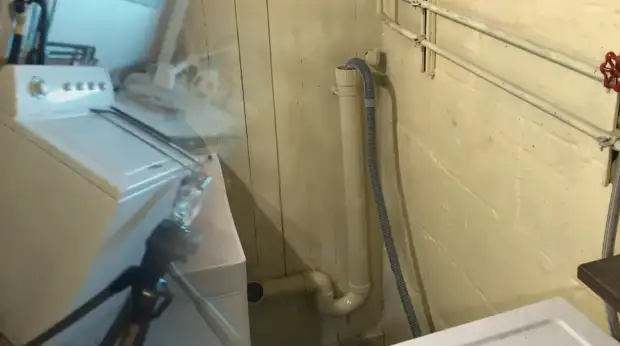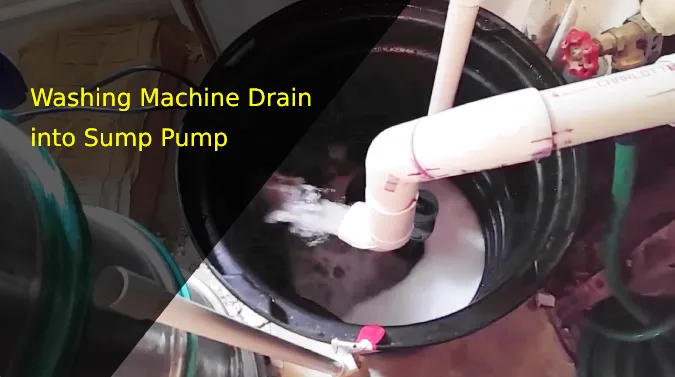Last Updated on May 18, 2023
Homeowners must ensure their washing machine water is appropriately directed for a safer and more efficient laundry experience. Draining into the sump pump or storm sewer line may seem convenient, but hidden drawbacks and potential issues could cause damage in the short and long run.
Neglecting to dispose of washing machine wastewater adequately can have disastrous consequences, from contamination of groundwater resources to soil erosion. For safety and health reasons, we must be conscious of the chemicals in our detergents.
However, you can safely direct the drain hose to the sump pump if you do not use detergent or harsh chemicals in the washing machine while washing clothes. This article will explore proper steps for appropriately directing washing machine water into your sump pump to protect your health and the environment.
Can Washing Machine Drain into Sump Pump: Why You Shouldn’t?

Most homeowners don’t think twice about where the water from their washing machine goes once it goes down the drain. But redirecting your washing machine’s water to a sump pump could be dangerous. These include:
Overloading the Sump Pump
Sump pumps are designed to remove excess water from your basement or crawl space. While efficient, they can quickly become overwhelmed when too much water enters at once. Regularly redirecting the water from your machine into your sump pump can cause the pump to work overtime and eventually fail.
This can result in costly repairs and potential flooding in your home. Ensuring your sump pump is solely used for its intended purpose and not overloaded with additional water is critical.
Contamination of Groundwater
Water from your washing machine contains detergents, fabric softeners, and other chemicals that can harm the environment. If you drain your washing machine’s dirty water into a sump pump, the water can seep into the ground and contaminate the local groundwater.
This pollution can have disastrous effects on local ecosystems and wildlife. Directing your washing machine water to a drainage field that filters out harmful chemicals before reaching the groundwater is best.
Soil Erosion
Redirecting the water from your washing machine into a sump pump can also cause soil erosion. The force of the water can wash away surrounding soil and vegetation, which can lead to a host of problems.
Soil erosion can cause flooding, decrease soil fertility, and damage local ecosystems. It’s crucial to be mindful of where your washing machine water goes and ensure it doesn’t negatively impact the environment.
Water Backup to Washing Machine
If your sump pump becomes overwhelmed with water, it can cause water to back up into your washing machine. This can cause structural damage to the machine and potentially flood your home.
It’s essential to ensure your washing machine is connected to a drain that can handle the volume of water it produces. If unsure, it’s best to consult a professional plumber to assess your plumbing system. Note that directing your washing machine to your sump pump is only safe if you don’t use detergent or harsh chemicals.
How to Safely Connect Your Washing Machine to a Sump Pump?

Connecting your washing machine to a basement sump pump can be a convenient and efficient way to remove wastewater from your home. It can also be a cost-effective alternative to traditional drainage systems.
Here are some essential steps you should take when connecting your washing machine to the sump pump:
STEP 1. Turn Off the Power and Water Supply
Before starting any electrical work on the washing machine, turning off the power supply is essential. You can unplug the washing machine from the socket or turn off the circuit breaker connected to the washing machine.
Turning off the water supply from the washing machine shut off valve that feeds water into the machine is also essential. You can disconnect the water hose from the washing machine or turn off the main water valve that supplies water to the house.
STEP 2. Locate the Washing Machine Drain Hose
The washing machine drain hose is usually located near the top or bottom at the back of the machine. It is a flexible plastic tube connected to the washing machine’s back. You can follow the hose to locate the drainpipe where it empties the wastewater.
Ensure the hose is long enough to connect to the sump pump but not too long to avoid kinks or bends that might obstruct the water flow.
STEP 3. Measure the Distance
Once you have located the washing machine drain hose, you must measure the distance between the machine and the pump. This will determine the hose length you need to connect the machine to the pump.
You can use a measuring tape to get an accurate measurement. Choosing the right hose size is essential, depending on the distance and the pump’s capacity. You can consult a plumbing professional to ensure you use the correct size.
STEP 4. Cut the PVC Pipe to the Correct Length
Before connecting your washing machine to a sump pump, you must cut a piece of PVC pipe to the correct length. Measure the distance between the washing machine’s drain hose and the sump pump, then add a few inches to ensure the pipe is long enough. Using a PVC pipe cutter, cut the pipe to the desired length.
STEP 5. Install a Check Valve

A check valve is an essential part of a sump pump system. It allows water to flow in one direction while preventing it from backing up. Installing a check valve will ensure that water does not flow back into the washing machine or the house.
Now attach the check valve to the end of the PVC pipe using PVC cement or glue. Make sure to follow the manufacturer’s instructions for proper installation. With the check valve securely in place, you must connect the PVC pipe to the washing machine’s drain hose.
STEP 6. Connect the Pipe to the Washing Machine’s Drain Hose
Next, using a hose clamp, you’ll need to connect one end of the PVC pipe to your washing machine’s drain hose. Slide the hose clamp onto the end of the PVC pipe and then slide the pipe over the end of the washing machine’s drain hose. Tighten the hose clamp with a screwdriver to ensure a secure connection.
STEP 7. Connect the Other End of the PVC Pipe
After successfully connecting the PVC pipe to the washing machine’s drainage hose, the next step is connecting the pipe’s other end to the sump pump. You’ll need to measure the distance from the washing machine to the sump pump and cut the PVC pipe accordingly.
Use another fitting to connect the PVC pipe securely to the sump pump. Tighten the connection with a hose clamp to ensure it’s stable and not leaking.
STEP 8. Turn On the Power and Water Supply
Before switching on the electrical power and water supply, ensure all connections are securely fitted with no signs of leakage. Also, ensure the sump pump has been set up correctly and functions to avoid any unexpected water damage.
Once everything is in place, power your washing machine’s energy and water supply. However, if you discover that your shut off valve is leaking (when installing a check valve), replace it immediately with a new washing machine shut off valve.
STEP 9. Test the Washing Machine Water Flow
After turning on the power and water supply, it’s time to test the water flow of your washing machine. Run a quick cycle to check if the water flows smoothly through the PVC pipe and drains into the sump pump.
If you notice any issues, check the connections and make sure they are secure and fastened. If everything is working correctly, congratulations! You can now enjoy a laundry room with a reliable and efficient drainage system.
What is the cost of a new washing machine shut off valve?
Whenever you notice your washing machine’s shut off valve is leaking, you’ll have to buy a new one and replace the old one. Otherwise, your utility bill may go up.
A new washing machine shut off valve can come at an affordable price, ranging from $22 to $42. Despite being relatively cheap, these valves are essential in preventing catastrophic floods caused by water leaks or burst pipes.
Check out this list if you’re looking for an affordable washing machine shut off valve. Ensure you have a reliable shut off valve that stops water supply immediately if your pipes leaking.
Can You Run a Sump Pump Into a Washing Machine Drain?

Running a sump pump into your washing machine drain is not advisable. The reasons are manifold. A sump pump is usually designed to pump out groundwater, which may collect in a sump pit.
Connecting it to your washing machine drain may cause water to flow back into your machine hose. This is because a washing machine usually has a U-shaped drain pipe or p-trap that holds water so sewer gas does not enter your home.
Also, connecting a sump pump to the same drain may force water to go up the drain and back into your washing machine. This can cause damage to your washing machine and create a mess in your home.
Moreover, the sump pump’s water discharges usually contain impurities like silt, sand, and debris. When these impurities mix with laundry soap, it can create scum that will cling to your clothes, making them appear dull and dingy.
Can You Put a Washing Machine in the Basement Near a Sump Pump?
You can place a washing machine in your basement near the sump pump. However, ensuring the washing machine is positioned high enough above the sump pump is crucial. If the washing machine drains into the sump pump, it could result in water backing up into the machine, which could cause damage to the machine.
This is why ensuring the washing machine is safely and correctly positioned is essential to prevent damage, flooding, or water backup.
How Far Can You Drain a Washing Machine to a Sump Pump?
The maximum distance you can drain a washing machine to a sump pump is typically around 2 meters. This is because the sump pump is designed to handle a certain amount of water flow, and exceeding this limit can cause it to malfunction or fail altogether.
Also, the height of the water column can affect the sump pump’s ability to handle the water flow. To ensure that your washing machine is draining properly, it’s essential to ensure that the drain hose is secured correctly and that there are no kinks or obstructions in the hose.
You should also ensure that the sump pump is installed correctly and has the appropriate capacity for your needs.
Keep Dirty Washing Machine Water Away from Sump Pumps to Protect the Water Supply
Generally, you shouldn’t drain your washing machine into the sump pump because it can pollute groundwater. But if you must direct the drain to the sump pump, ensure the water is contaminant-free, and avoid detergents or harsh chemicals.
However, for eco-friendly and safe wastewater disposal, it is advisable to consider alternative options such as gray water systems or natural laundry detergents. By taking these steps, you can protect the environment and promote a healthier home for your family.


